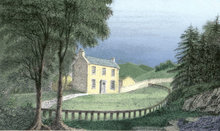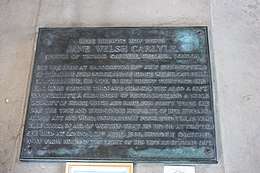Jane Welsh Carlyle
_by_Samuel_Laurence_detail.jpg)
Jane Welsh Carlyle (14 January 1801 – 21 April 1866) was a Scottish writers. She was the wife of essayist Thomas Carlyle.
Their long marriage was close but tempestuous, complicated by other relationships on both sides, though these appear to have been platonic, as their own was believed to have been. Jane had first been introduced to Thomas by her tutor, who was in love with her but unable to break his engagement. Her closest romantic relationship seems to have been with Geraldine Jewsbury, though she resented Jewsbury’s free love life. Jane’s many passionate letters to her caught the interest of Virginia Woolf.
Life
Jane Baillie Welsh was born in Haddington, East Lothian, 14 January 1801. She was the daughter of Dr John Welsh MD (1770-1819) and his wife, Grace Caplegill.[1]
Marriage to Thomas Carlyle
Jane had been introduced to Carlyle by her tutor Edward Irving, with whom she came to have a mutual romantic (although not sexually intimate) attraction.
The couple married in 1826 and for the first six years lived on a farm in Scotland; the marriage was often unhappy. Thomas was always busy writing and Jane remained dutiful in doing the housework. Their voluminous correspondence has been published, and the letters show that the couple's affection for each other was marred by frequent quarrels. Samuel Butler once wrote: "It was very good of God to let Carlyle and Mrs Carlyle marry one another, and so make only two people miserable and not four". Carlyle's biographer James Anthony Froude posthumously published his opinion that the marriage remained unconsummated.[2][3]

Historian Paul Johnson notes in Creators that she not only irked her husband but made prickly comments about others, such as fellow female writer George Eliot (Mary Ann Evans), of whom she said: "She looks Propriety personified. Oh, so slow!"
Jane was also jealous of a friendship her husband had with the socialite and hostess Lady Harriet Mary Montagu (later Lady Ashburton). The friendship was non-sexual yet they still spent a lot of time together. Jane expressed her jealousy and anger in a letter dated in 1856.
Relationship with Geraldine Jewsbury


Jane had a long lasting relationship (1841-1866) with fellow writer Geraldine Jewsbury. The two women first met when Thomas invited Geraldine to Cheyne Row, where Thomas and Jane lived. Geraldine had written to Thomas prior to the invitation admiring his work,[4] and also expressing her religious doubt. Geraldine was going through a depressive time, but she also contacted Thomas in the hopes of entering the literary realm in England. When Geraldine and Jane met, their friendship turned out to be more of a romantic relationship. It is evident both women had feelings for each other, but there is no evidence of them being lovers. Jane always remained dutiful to her husband and neither had acted upon any romantic feelings. This caused a lot of jealousy between the two women as Jane always remained married to Thomas and Geraldine had lovers of her own. However, they both had passionate feelings towards one another and that passion is expressed in their many letters to one another: as Geraldine wrote, “I feel towards you much more like a lover than a female friend”.[5]
They often had disagreements about common social issues of the era such as the place of men in women's lives and the purpose of women in general. Geraldine wasn't opposed to marriage, but she thought man and woman should be equal in marriage; she didn't witness that with Jane and Thomas, and criticised the great man for it.[6] Jane often tried to set up Geraldine with suitable bachelors in London. However, none of them stuck (Geraldine never married).

When they were on good terms, Jane helped Geraldine with many of her literary works. Jane helped edit, and publish, two of Geraldine's most popular novels, Zoe: the History of Two Lives,[7] and The Half Sisters, which Geraldine wanted to dedicate to her.[8] Jane was often burdened with the work, however, and also showed some jealousy over Geraldine's literary success. She had trouble accepting how sociable Geraldine was and how many more friends she had as well.
In 1857, Geraldine became romantically involved with Walter Mantell. The two women became very distant from one another and when they did write letters to each other, they were fighting.
Towards the end of her life Jane was very ill. Geraldine would spend time taking care of her friend and liked feeling needed by her. When Jane was feeling better, however, she would turn to Thomas instead. Geraldine was often jealous of that fact, but was there at the death of what she called “the friend of my heart”.[9]
These two women had a very interesting relationship from a romantic, literary, and friendly perspective. Virginia Woolf based a 1929 article in the Times Literary Supplement on Geraldine's letters to Jane Carlyle,[10] later published in ‘’The Second Common Reader’’.[11] Their passionate relationship was recognized among their literary peers despite the ups and downs of their friendship.[3][12][13]
She died in London on 21 April 1866 and is buried with her father in St Mary's Collegiate Church, Haddington. The grave (railed off) stands inside the church close to the west end.
Works
Thomas published his highly self-critical "Reminiscences of Jane Welsh Carlyle" out of guilt after he read her diary posthumously. The Scottish philosopher David George Ritchie, a friend of the Carlyle family, published a volume of her letters in 1889 under the title The Early Letters of Jane Welsh Carlyle. In 1973, American scholar G. B. Tennyson described her as "one of the rare Victorian wives who are of literary interest in their own right...to be remembered as one of the great letter writers (in some respects her husband’s superior) of the nineteenth century is glory beyond the dreams of avarice."
Otherwise, Jane didn't act upon her literary talent. She was once thought to have written Jane Eyre, but she never went so far as to even co-author a novel with Geraldine.
Memorials
A plaque to Jane stands on the west side of George Square in Edinburgh.
References
- ↑ Grave of Welsh family, St Mary's Church, Haddington
- ↑ Froude, J. A. (1903). My Relations With Carlyle. New York: Charles Scribner's Sons.
- 1 2 Cruikshank, Margaret. "Geraldine Jewsbury and Jane Carlyle". JSTOR 10.2307/3346151. Missing or empty
|url=(help) - ↑ V Woolf, The Second Common Reader (Penguin [1932]) p. 143
- ↑ Quoted in V Woolf, The Second Common Reader (Penguin [1932]) p. 144
- ↑ V Woolf, ‘The Second Common Reader (Penguin [1932]) p. 145
- ↑ V Woolf, The Second Common Reader (Penguin [1932]) p. 147-8
- ↑ V Woolf, The Second Common Reader (Penguin [1932]) p. 150
- ↑ Quoted in A Booth, Homes and Haunts (2016) p. 232
- ↑ A Booth, Homes and Haunts (2016) p. 244
- ↑ V Woolf, The Second Common Reader (Penguin [1932]) p. 143
- ↑ Howe, Susanne (1935). Geraldine Jewsbury, Her Life and Errors. London: George Allen & Unwin.
- ↑ Clarke, Norma (1990). Heights: Writing, Friendship, Love: The Jewsbury Sisters, Felicia Hemans, and Jane Welsh Carlyle. London: Routledge.
- Uglow, Nathan. "Jane Welsh Carlyle". The Literary Encyclopedia. Ed. Robert Clark, Emory Elliott and Janet Todd.
Further reading
- Ashton, Rosemary (2001). Thomas and Jane Carlyle: Portrait of a Marriage. London: Chatto & Windus.
- Bourne, H.R. Fox (1882). "Carlyle and His Wife," The Gentleman's Magazine, Vol. CCLII, pp. 685–705.
- Brown, Francis (1910). "Miss Martineau and the Carlyles," The Atlantic Monthly, Vol. CVI, pp. 381–387.
- Collis, John Stewart (1971). The Carlyles: A Biography of Thomas and Jane Carlyle. London: Sidgwick & Jackson.
- Drew, Elizabeth A. (1928). Jane Welsh and Jane Carlyle. New York: Harcourt, Brace & Company.
- Fielding, K. J.; David R. Sorensen & Rodger L. Tarr (2004). The Carlyles at Home and Abroad. Aldershot, Hants, England: Ashgate Pub.
- Hanson, Lawrence & Elisabeth Hanson (1952). Necessary Evil; the Life of Jane Welsh Carlyle. London: Constable.
- Ireland, Annie E. (1888). "George Eliot and Jane Welsh Carlyle," The Gentleman's Magazine, Vol. CCLXIV, pp. 229–238.
- Ireland, Annie E. (1891). Life of Jane Welsh Carlyle. New York: C.L. Webster & Co.
- Morrison, Nancy Brysson (1974). True Minds: The Marriage of Thomas and Jane Carlyle. London: J.M. Dent & Sons.
- Oliphant, Margaret (1883). "Mrs. Carlyle," The Contemporary Review, Vol. XLIII, pp. 609–628.
- Scudder, Townsend (1939). Jane Welsh Carlyle. New York: The Macmillan Company.
- Surtees, Virginia (1986). Jane Welsh Carlyle. Salisbury, Wiltshire: Michael Russell.
External links
| Library resources about Jane Welsh Carlyle |
| By Jane Welsh Carlyle |
|---|
| Wikiquote has quotations related to: Jane Welsh Carlyle |
| Wikimedia Commons has media related to Jane Welsh Carlyle. |